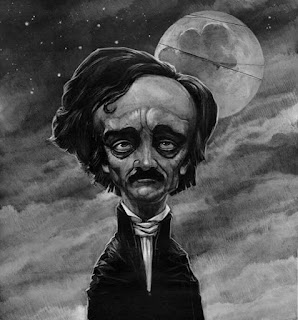June gloom
 |
| Photo uploaded by user Erisa on Pinterest. |
In “The Sleeper,” June’s placement in the middle of the calendar is emphasized or heightened by the other temporal references. The poem is set “at midnight, in the month of June.” Thus, it is not only the middle of the year, but also the middle of the night and, furthermore, the moment straddling the dividing line between one day and the next day.
In “A Pæan,” the month is used to characterize the relative youth of the dead heroine: “Thou died’st in thy life’s June.” Poe does this often in other poems—he refers to the human lifespan by reference to the calendar or the clock. So, for example, in “Tamerlane” (1827), we are told that “boyhood is a summer sun” and, in “Ulalume” (1847), Poe sets the action in October to denote a dead-end of dementia.
Poe goes further in “A Pæan,” using June to demarcate a sort of muddy middle ground, a moderation that we suspect is suspect to the poet:
Thou died’st in thy life’s June —
But thou did’st not die too fair:
Thou did’st not die too soon,
Nor with too calm an air.
This would be contradictory or textually problematic if we thought Poe was trying to be precise by using June to describe the timing, but here the qualifications suggest that “life’s June” is a broad period that outlasts beauty, youth and serenity.
Life’s June, for Poe, is a time susceptible to the great risk of one losing one’s way in life. The danger of death is not far-fetched if you are a beautiful woman in Poe’s world, but it is not just losing one’s life that is likely, as one could also lose one’s perspective and bearings.
In “The Sleeper,” the precise midpoint of midsummer, mid-night, between one day and another, is a time when the “dew” of forgetfulness drips from the “mystic moon” and mesmerizes the natural world into a “conscious slumber.” Is this not the same topsy-turvy perspective that leads us to consider someone who died in the prime of her life as not having died “too fair … too soon,/Nor with too calm an air?” June is a Twilight Zone, a little reminiscent of the midway of life signaled by Dante (from the Divine Comedy: “When half way through the journey of our life/I found that I was in a gloomy wood,/ because the path which led aright was lost”).
And so, paradoxically, June is both the height of power—when life is in full bloom—and of vulnerability—when its vivaciousness can be ensnared in the fog of forgetfulness, or even death.
Let life, then, as the day-flower, fall
With the noon-day beauty—which is all.
(“Tamerlane”).




Comments
Post a Comment